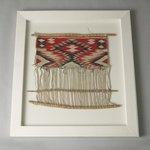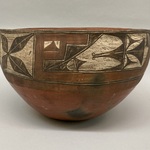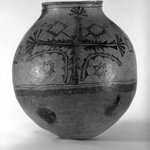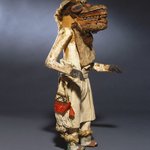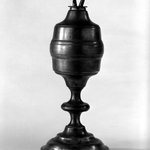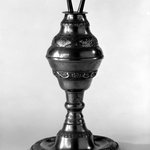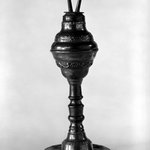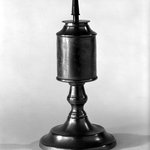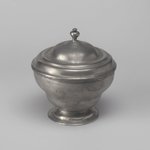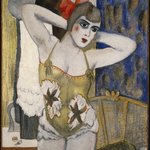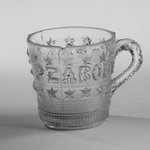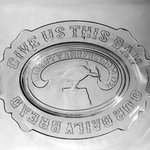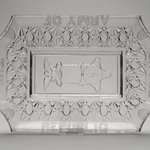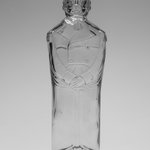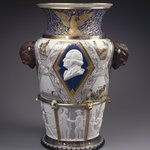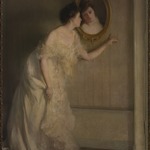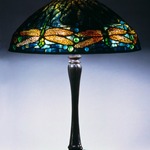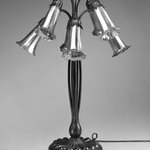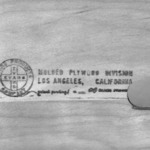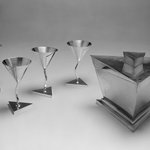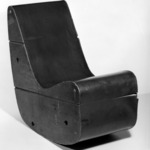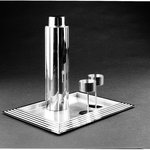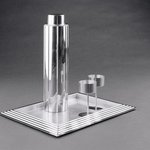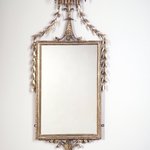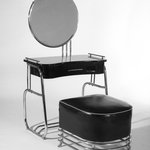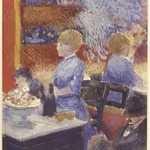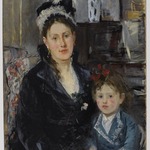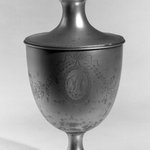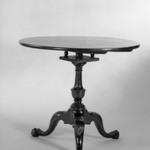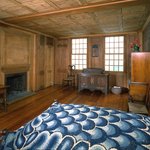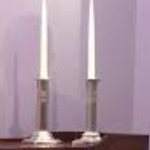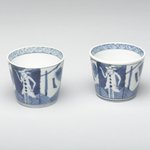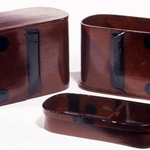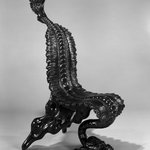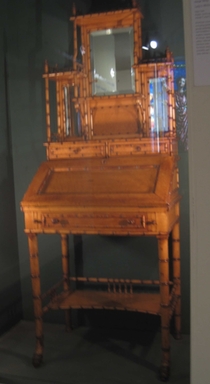
Lady's Writing Desk
Decorative Arts and Design
On View: Decorative Art, 20th-Century Decorative Arts, 4th Floor
From the 1830s to the 1870s, designers of furniture, ceramics, metalwork, and other household objects drew their inspiration from historical styles such as the Gothic, Renaissance, and Rococo (see the Period Rooms along the corridor to your right). Beginning in the 1860s, designers and manufacturers responded to increased interest in other cultures and advocated a rejection of industrialized production. While today we strive to reflect more sensitively and knowledgeably on the appropriation of styles, symbols, and practices from cultures other than our own, in the nineteenth century there was no such awareness. European and American designers and manufacturers copied, adopted, and exploited images and customs from other cultures without respect or recognition. These manufacturers were trying to create interest in what was unfamiliar, regardless of sensitivity.
Objects both made in Japan and those that appropriated forms and motifs from Japanese models were especially popular, particularly after Commodore Matthew Perry forcibly opened Japanese ports to European and American trade in 1853. Although many of the objects on display here were industrially manufactured, critics promoted objects from cultures, such as Japan and the Islamic world, and historical styles, such as the Gothic, that evoked what were thought to be less industrialized and more “honest” forms of production.
During the 1850s, the development of wood pulp paper allowed for a proliferation of inexpensive magazines and books to be published, and some of these were directed toward the growing middle class, which was enjoying increased leisure time and more disposable income. Women were encouraged in these publications to furnish their homes with lighter furniture and objects. Often, this period of decoration is called the Aesthetic movement, “art for art’s sake,” or “the artistic interior,” and its profusion of highly decorated and painted and gilded surfaces on simple forms dominated domestic interiors.
Here, Ottoman-inspired vine patterns decorate ewer and vase forms, while Japanese motifs are loosely interpreted on a plaque, a silver Tiffany vase, and a gilt-handled vase. The writing desk by R. J. Horner is constructed of yellow-stained maple, resembling bamboo.
Objects both made in Japan and those that appropriated forms and motifs from Japanese models were especially popular, particularly after Commodore Matthew Perry forcibly opened Japanese ports to European and American trade in 1853. Although many of the objects on display here were industrially manufactured, critics promoted objects from cultures, such as Japan and the Islamic world, and historical styles, such as the Gothic, that evoked what were thought to be less industrialized and more “honest” forms of production.
During the 1850s, the development of wood pulp paper allowed for a proliferation of inexpensive magazines and books to be published, and some of these were directed toward the growing middle class, which was enjoying increased leisure time and more disposable income. Women were encouraged in these publications to furnish their homes with lighter furniture and objects. Often, this period of decoration is called the Aesthetic movement, “art for art’s sake,” or “the artistic interior,” and its profusion of highly decorated and painted and gilded surfaces on simple forms dominated domestic interiors.
Here, Ottoman-inspired vine patterns decorate ewer and vase forms, while Japanese motifs are loosely interpreted on a plaque, a silver Tiffany vase, and a gilt-handled vase. The writing desk by R. J. Horner is constructed of yellow-stained maple, resembling bamboo.
CULTURE
American
MEDIUM
bird's-eye maple, silvered glass, leather
DATES
late 19th century
DIMENSIONS
69 3/4 x 27 x 18 in. (show scale)



MARKINGS
no marks
SIGNATURE
no signature
INSCRIPTIONS
no inscriptions
COLLECTIONS
Decorative Arts and Design
ACCESSION NUMBER
1989.158
CREDIT LINE
Alfred T. and Caroline S. Zoebisch Fund
CATALOGUE DESCRIPTION
Legs, spindles and applied moldings to simulate bamboo. Raised on four legs, front feet splayed forward, joined below mid-point by double stretchers connected by three short spindles on sides and five on back, supporting a partial lower shelf. Slant-front with inset panel and wooden escutcheon above narrow drawer with two turned wooden pulls, between recessed wooden slat supports each with turned wooden pull. Super-structure with pair of narrow drawers, each with one turned wooden pull, above which is two-tiered spindled galleries with large rectangular beveled mirror at top center and an elongated beveled mirror at each side. Each tier surrounded by spindled galleries on three sides, open to front. Shelf below central mirror supported by inward-curving brackets with turned drop finials. Interior of desk fitted with new dark-red leather writing surface trimmed with tooled gold border and four small square cubbyholes at each corner against back interior.
CONDITION - Very good original condition lightly cleaned and waxed.
EXHIBITIONS
MUSEUM LOCATION
This item is on view in Decorative Art, 20th-Century Decorative Arts, 4th Floor
CAPTION
R.J. Horner & Company (1886-1915). Lady's Writing Desk, late 19th century. bird's-eye maple, silvered glass, leather, 69 3/4 x 27 x 18 in. Brooklyn Museum, Alfred T. and Caroline S. Zoebisch Fund, 1989.158. Creative Commons-BY (Photo: , CUR.1989.158.jpg)
IMAGE
overall, CUR.1989.158.jpg., 2019
"CUR" at the beginning of an image file name means that the image was created by a curatorial staff member. These study images may be digital point-and-shoot photographs, when we don\'t yet have high-quality studio photography, or they may be scans of older negatives, slides, or photographic prints, providing historical documentation of the object.
RIGHTS STATEMENT
Creative Commons-BY
You may download and use Brooklyn Museum images of this three-dimensional work in accordance with a Creative Commons license. Fair use, as understood under the United States Copyright Act, may also apply.
Please include caption information from this page and credit the Brooklyn Museum. If you need a high resolution file, please fill out our online application form (charges apply).
For further information about copyright, we recommend resources at the United States Library of Congress, Cornell University, Copyright and Cultural Institutions: Guidelines for U.S. Libraries, Archives, and Museums, and Copyright Watch.
For more information about the Museum's rights project, including how rights types are assigned, please see our blog posts on copyright.
If you have any information regarding this work and rights to it, please contact copyright@brooklynmuseum.org.
RECORD COMPLETENESS
Not every record you will find here is complete. More information is available for some works than for others, and some entries have been updated more recently. Records are frequently reviewed and revised, and we welcome any additional information you might have.
